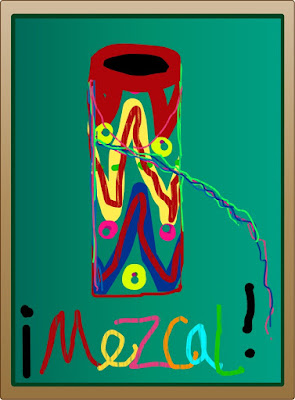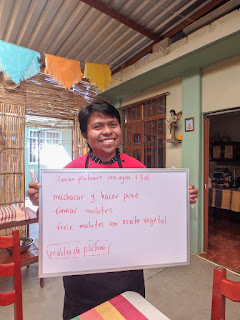Life in Mexico has given us a major case of culture shock and a sense of connection and disconnection. How do we explain Donald Trump's bigotry to people who welcome us like members of their own family? Can we make sense out of anyone's belief that Mexican people would leave the beaches of Huatulco or the clean fresh air of San Cristobal del las Casas without a very good reason?
We left Huatulco on a sweltering night and folded ourselves
into an ADO bus for the 12 hour trip to San Cristobel. Crowded bus and winding road
notwithstanding, we both managed to get a little sleep by the time we rolled
into gorgeous San Cristobal nestled in a high mountain valley. Because of a small typo
in the address of our hotel, we sent a poor cab driver into wild peregrinations
around the city in the morning rush hour traffic. Each time we thought we were
on the right track, we would wind up in front of some derelict building or
other. Finally, we just asked him to please find us some kind of hotel, which
he promptly did.
 After a morning descanso y desayuno, we located a city map
and began our orientation phase to downtown San Cristobel. Right from the start,
it was very clear that this was not just another Oaxaca. The town is much
smaller, much more diverse, and actually a bit tidier than Oaxaca appeared to
be.
After a morning descanso y desayuno, we located a city map
and began our orientation phase to downtown San Cristobel. Right from the start,
it was very clear that this was not just another Oaxaca. The town is much
smaller, much more diverse, and actually a bit tidier than Oaxaca appeared to
be.
Three walking streets connect you with most of the museums, churches,
mercadores, restaurants and night spots along with other sights. The center of
the city, for us, was the Templo De Santo Domingo (where El Papa had just
stopped a few days before), and the nearby park, complete with bandstand, that
was filled with tourists, vendadores, musicians all swirling about in an
amazingly colorful dance.
Our curiosity was piqued right away by the street
vendors who were clearly from a very distinct community, which we later learned
was Chemula – about an hour from San Cristobel. Men, women, and children, primarily from that town, sold their wares day and night lugging huge bundles of flower-bedecked blouses, rugs, scarves, toys,
bracelets, hats, candy, pastries and sundry items up and down the walking
streets or from small stalls on the north side of town. “No Gracias” more or less
became our greeting as we were bombarded by sales pitches of every kind. Oddly,
it was not as bothersome as it might sound especially since the vendors did not
persist and were very gracious to us despite our refusals. It was just part of
the scene.
 The second day, we managed to locate our actual hotel, Hotel
Ganesha, a kind of yoga retreat/hostel that really proved to be an oasis from
the city hubbub. Lynn tried a yoga class there and Eric, per usual, slept
in.
The second day, we managed to locate our actual hotel, Hotel
Ganesha, a kind of yoga retreat/hostel that really proved to be an oasis from
the city hubbub. Lynn tried a yoga class there and Eric, per usual, slept
in.
Later, with map in hand, we
developed our plan to see as many of the sights as possible in the time we had
for San Cristobel. The Centro De Textiles Del Mundo Maya, located in an old
convent, was simply stunning. Rooms filled with ancient samples of Maya woven
textiles, along with drawers full of more examples that underscore the
beautifully detailed and distinctive designs still found in the small
villages around San Cristobel.
 Not far from there was Na Bolom. Once a private
residence of a anthroplogist and his photographer wife, it is a fascinating
look at how the rest of the world came to learn of the still extant Mayan
culture, through the efforts of these two people. It's quirky and dignified at
the same time, with many photographs and objects of art from the couple’s
collection. Other museums we discovered included the Museum of Amber and
the Museum of Bichos and Insectos,
an old fashioned drawer-style museum with an astounding collection of the bugs
and insects indigenous to Chiapas and the Mexican Isthmus area that included a bewildering
variety of scarab beetles, butterflies, scorpions, spiders including a pet-able
live tarantula.
Not far from there was Na Bolom. Once a private
residence of a anthroplogist and his photographer wife, it is a fascinating
look at how the rest of the world came to learn of the still extant Mayan
culture, through the efforts of these two people. It's quirky and dignified at
the same time, with many photographs and objects of art from the couple’s
collection. Other museums we discovered included the Museum of Amber and
the Museum of Bichos and Insectos,
an old fashioned drawer-style museum with an astounding collection of the bugs
and insects indigenous to Chiapas and the Mexican Isthmus area that included a bewildering
variety of scarab beetles, butterflies, scorpions, spiders including a pet-able
live tarantula. By sheer luck, Lynn managed to locate an outstanding
guide, Juan Hernandez from Nichim Ecotours, who not only arranged
our next planned stop at Palenque, but agreed to take us out to Chemula on his
day off, to show us the secrets of his home village, and to offer us a very
unique look at the life of these indigenous people. They not only have
distinctive and richly colored clothing that they offer for sale in San
Cristobel, they have an entirely self sufficient culture, complete with religious
beliefs that preceded the Catholic incursions. Thanks to Juan, we learned that
what appears to be a small Catholic church in the middle of the village is, in
fact, nothing like a Catholic church at all!
By sheer luck, Lynn managed to locate an outstanding
guide, Juan Hernandez from Nichim Ecotours, who not only arranged
our next planned stop at Palenque, but agreed to take us out to Chemula on his
day off, to show us the secrets of his home village, and to offer us a very
unique look at the life of these indigenous people. They not only have
distinctive and richly colored clothing that they offer for sale in San
Cristobel, they have an entirely self sufficient culture, complete with religious
beliefs that preceded the Catholic incursions. Thanks to Juan, we learned that
what appears to be a small Catholic church in the middle of the village is, in
fact, nothing like a Catholic church at all!
Stepping inside, you find yourself
transported as you see a spiritual community that honors the Christian saints
in a unique and very personal manner. No Catholic priests, or priests of any
kind, are permitted to preach within the walls of the church. Evangelism has
been entirely and somewhat forcefully rejected. Instead, families come to sit
in front of their particular saint to chant, usually in a Mayan dialect, or to
light row upon row of candles that are placed on the floor, or to spread pine
boughs to show reverence for spirits of the natural world. There are no pews.
Everyone sits on the floor. From
the ceiling there are long, diagonal drapes that symbolize the mountains – an
ancient symbol of faith. The altar, as such, is decorated with flowers and
draped with special orchids that symbolize life and regeneration. The main
figure depicted in the altar space is John the Baptist, who is considered to be
much more important that Jesus Christ. In fact, Christ is only depicted in one
painting being baptized by John.
 |
| San Juan Chemula |
Outside, on the church door colorful
symbols of life and appreciation of nature, along with ubiquitous orchids
replace the usual hagiography one finds in other churches. The cross, standing
in the square before the church, is not, in fact, a Christian cross at all, but yet another much older symbol that predates the arrival of the Catholics in the 16th
century. We felt truly blessed to have Juan with us. Otherwise, we might never
have had the deeper appreciation of a different kind of spiritual life.
Afterwards, we visited another nearby village with Juan
where we were invited into a home and textile market to see the
fabrics and designs similar to those on display at the textile museum while
several women prepared native tortilla dishes for us to enjoy. We also sampled something called Puj (push) which is like a very smooth and potent
tequila.
We topped the night of with a viewing of a dance/play called
Palenque Rojo which was a fascinating retelling of the Mayan story of King
Palanque’s life and death. Dance, drums, and chants replaced dialog. We followed that with a visit to Café Revolucion
where we drank mescal and tequila while listening to a foot stomping band from
Vera Cruz who took us through a medley of fandango music that had everyone in
the café dancing, thumping on tables and/or clapping hands.
 Our last full day in San Cristobel was highlighted by a walk
through the cavernous municipal Mercado which is an indescribable explosion of
smells, food, sights, sounds, and people. Want a nice fresh pollo for supper?
Our last full day in San Cristobel was highlighted by a walk
through the cavernous municipal Mercado which is an indescribable explosion of
smells, food, sights, sounds, and people. Want a nice fresh pollo for supper?
or maybe some delicious marzipan perros?





















